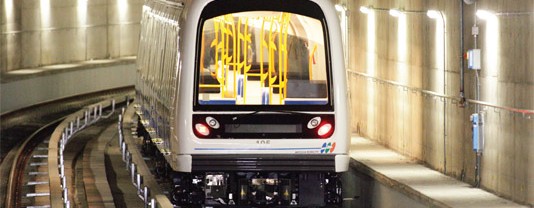Not many cities in Italy or Europe have built themselves a metro system in recent years. Brescia, a medium-sized city, is without doubt an exemplary and extremely interesting case thanks to the solutions adopted (a medium-sized automatic light metro system) and for its unique vision of integration between the various methods of transport available, from bike sharing (16,000 people subscribed to the scheme in a city with 200,000 inhabitants) to studies on the use of tram-train systems to provide services in the hinterland. Just over a year since the metro was officially opened, the results, in terms of ridership and above all in new users who have switched over to public transport, are significant. We spoke to Marco Medeghini, engineer, General Manager of Brescia Mobilità and Metro Brescia S.r.l..
Railway Engineering: Mr. Medeghini, Brescia’s automatic light metro was officially opened just over a year ago, on 2 March 2013, and it’s already a success. You must be really pleased.
Marco Medeghini:Considering the new aspects and the innovation you mentioned earlier, (in terms of Brescia being the smallest Italian city and one of the smallest in Europe to have a metro), we were always particularly cautious. Now we can say, with satisfaction, that we have achieved a good result, both in terms of ridership, approximately 12 million (as opposed to the 10 million expected in the ten months of operation in 2013), averaging approximately 40,000 passengers/day, and in the reduction of road traffic (2% in the overall average, 5-10% within the urban context) which has led to less congestion and a subsequent reduction in pollutant emissions and journey time costs.
Not many cities in Italy or Europe have built themselves a metro system in recent years. Brescia, a medium-sized city, is without doubt an exemplary and extremely interesting case thanks to the solutions adopted (a medium-sized automatic light metro system) and for its unique vision of integration between the various methods of transport available, from bike sharing (16,000 people subscribed to the scheme in a city with 200,000 inhabitants) to studies on the use of tram-train systems to provide services in the hinterland. Just over a year since the metro was officially opened, the results, in terms of ridership and above all in new users who have switched over to public transport, are significant. We spoke to Marco Medeghini, engineer, General Manager of Brescia Mobilità and Metro Brescia S.r.l..
Railway Engineering: Mr. Medeghini, Brescia’s automatic light metro was officially opened just over a year ago, on 2 March 2013, and it’s already a success. You must be really pleased.
Marco Medeghini: Considering the new aspects and the innovation you mentioned earlier, (in terms of Brescia being the smallest Italian city and one of the smallest in Europe to have a metro), we were always particularly cautious. Now we can say, with satisfaction, that we have achieved a good result, both in terms of ridership, approximately 12 million (as opposed to the 10 million expected in the ten months of operation in 2013), averaging approximately 40,000 passengers/day, and in the reduction of road traffic (2% in the overall average, 5-10% within the urban context) which has led to less congestion and a subsequent reduction in pollutant emissions and journey time costs.
Full article is available only for registered users.
Click the link below to download pdf version of Railway Engineering
